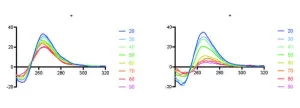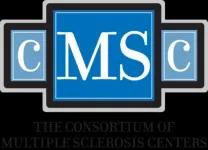(Press-News.org) Alzheimer’s disease starts with a sticky protein called amyloid beta that builds up into plaques in the brain, setting off a chain of events that results in brain atrophy and cognitive decline. The new generation of Alzheimer’s drugs — the first proven to change the course of the disease — work by tagging amyloid for clearance by the brain’s immune cells.
Now, researchers at Washington University School of Medicine in St. Louis have found a different and promising way to remove the noxious plaques: by directly mobilizing immune cells to consume them.
In a study published April 3 in Science Translational Medicine, the researchers showed that activating immune cells called microglia with an antibody reduces amyloid plaques in the brain and mitigates behavioral abnormalities in mice with Alzheimer’s-like disease.
The approach could have implications beyond Alzheimer’s. Toxic clumps of brain proteins are features of many neurodegenerative conditions, including Parkinson’s disease, amyotrophic lateral sclerosis (ALS) and Huntington’s disease. Encouraged by the study results, researchers are exploring other potential immunotherapies – drugs that harness the immune system – to remove junk proteins from the brain that are believed to advance other diseases.
“By activating microglia generally, our antibody can remove amyloid beta plaques in mice, and it could potentially clear other damaging proteins in other neurodegenerative diseases, including Parkinson’s disease,” explained the study’s senior author, Marco Colonna, MD, the Robert Rock Belliveau, MD, Professor of Pathology.
Microglia surround plaques to create a barrier that controls the damaging protein’s spread. They also can engulf and destroy the plaque proteins, but in Alzheimer’s disease they usually do not. The source of their passivity could result from a protein called APOE that is a component of amyloid plaques. The APOE proteins in the plaque bind to a receptor – LILRB4 – on the microglia surrounding the plaques, inactivating them, Yun Chen, co-first author on the study, explained.
For reasons that are still unknown, the researchers found that, in mice and people with Alzheimer’s disease, microglia that surround plaques produce and position LILRB4 on their cell surface, which inhibits their ability to control damaging plaque formation upon binding to APOE. The other co-first author Jinchao Hou, PhD, now a faculty member at Children’s Hospital of Zhejiang University School of Medicine in Zhejiang Province, China, treated mice that had amyloid beta plaques in the brain with a homemade antibody that blocked APOE from binding to LILRB4. After working with Yongjian Liu, PhD, a professor of radiology in Washington University's Mallinckrodt Institute of Radiology, to confirm that the antibody reached the brain, the researchers found that activated microglia were able to engulf and clear the amyloid beta plaques.
Clearing the amyloid beta plaques in mice also alleviates risk-taking behavior. Individuals with AD may lack memory of past experiences to inform their decisions. They may engage in risky behavior, making them vulnerable to becoming victims of fraud or financial abuse. Treating mice with an antibody to clear the plaques showed promise in altering the behavior.
After amyloid beta plaques form in the brain, another brain protein — tau — becomes tangled inside neurons. In this second stage of the disease, neurons die and cognitive symptoms arise. High levels of LILRB4 and APOE have been observed in AD patients in this later stage, Chen explained. It is possible that blocking the proteins from interacting and activating microglia could alter later stages of the disease. In future studies, the researchers will test the antibody in mice with tau tangles.
Drugs that target amyloid plaques directly can cause a potentially serious side effect. In Alzheimer’s patients, amyloid proteins build up on the walls of the arteries in the brain as well as other parts of brain tissue. Removing plaques from brain blood vessels can induce swelling and bleeding, a side effect known as ARIA. This side effect is seen in some patients receiving lecanemab, a drug approved by the Food and Drug Administration to treat Alzheimer’s. The mice used in this study lacked amyloid plaques on blood vessels, so the researchers could not evaluate what happens when blood vessel plaques are removed.
They are working with a different mouse model — one that does have plaques on brain arteries — to understand if this new approach also carries a risk of ARIA.
“Lecanemab, as the first therapeutic antibody that has been able to modify the course of the disease, confirmed the importance of amyloid beta protein in Alzheimer’s disease progression,” said author David Holtzman, MD, the Barbara Burton and Reuben M. Morriss III Distinguished Professor of Neurology. “And it opened new opportunities for developing other immunotherapies that use different methods of removing damaging proteins from the brain.”
END
Immunotherapy for Alzheimer’s disease shows promise in mouse study
Antibody mobilizes immune cells to clear amyloid plaques, reducing behavioral abnormalities
2024-04-03
ELSE PRESS RELEASES FROM THIS DATE:
Study gives first view of centromere variation and evolution
2024-04-03
A genomic study of human and selected nonhuman primate centromeres has revealed their unimaginable diversity and speed of evolutionary change.
In cell genetics, a centromere is the spot where two sister chromatids attach. A chromatid is one-half of a duplicated chromosome. United pairs of chromosomes have identifiable shapes because centromeres are not in a uniform position. As a cell prepares to divide, the machinery to separate and segregate chromosomes goes into action at each centromere location.
Unless the genetic material ...
New tools reveal how genes work and cells organize
2024-04-03
Proteins binding to RNA are important in many processes in the cell and can mediate a range of biological functions. A specialized structure in both DNA and RNA, the G-quadruplex, are regulatory elements involved in gene expression in both DNA and RNA. In the present work the researchers use theoretical predictions and molecular biology experiments to show that many chromatin-binding proteins bind to RNA G-quadruplexes. With this information they can classify proteins based on their potential to bind RNA G-quadruplexes.
The study uses a combination of experimental identification of RNA G-quadruplex-binding proteins and computational methods to build a prediction tool that identify the probability ...
New study shows LLMs respond differently based on user’s motivation
2024-04-03
A new study recently published in the Journal of the American Medical Informatics Association (JAMIA) reveals how large language models (LLMs) respond to different motivational states. In their evaluation of three LLM-based generative conversational agents (GAs)—ChatGPT, Google Bard, and Llama 2, PhD student Michelle Bak and Assistant Professor Jessie Chin of the School of Information Sciences at the University of Illinois Urbana-Champaign found that while GAs are able to identify users' ...
Top multiple sclerosis neurologists & scientists to headline CMSC Annual Meeting for healthcare professionals
2024-04-03
The leading research and educational conference for multiple sclerosis healthcare professionals in North America, the Consortium of Multiple Sclerosis Centers (CMSC) 38th Annual Meeting, returns to Nashville, Tennessee, May 29-June 1, 2024 at the Music City Center. The conference is renowned for its emphasis on reaching the interprofessional team involved in MS care, with learning opportunities for physicians, advanced practice clinicians, nursing professionals, pharmacists, mental health and rehabilitation specialists, dietitians, researchers, advocates and other members of the healthcare team involved in the management of people with MS.
...
Novel fabrication technique takes transition metal telluride nanosheets from lab to mass production
2024-04-03
Transition metal telluride nanosheets have shown enormous promise for fundamental research and other applications across a rainbow of different fields, but until now, mass fabrication has been impossible, leaving the material as something of a laboratory curiosity rather than an industrial reality. But a team of researchers has recently developed a novel fabrication technique—the use of chemical solutions to peel off thin layers from their parent compounds, creating atomically thin sheets—that looks set to finally deliver on the ultra-thin substance's promise.
The researchers describe their fabrication technique in a study published in Nature on April 3.
In ...
Two Jurassic mammaliaforms from China shed light on mammalian evolution
2024-04-03
Mammaliaforms are extinct and extant organisms that are closely related to mammals. Studying mammaliaforms helps scientists understand the evolutionary processes that led to various mammalian features.
In two consecutive studies in Nature, Dr. MAO Fangyuan and Dr. ZHANG Chi from the Institute of Vertebrate Paleontology and Paleoanthropology (IVPP) of the Chinese Academy of Sciences, together with colleagues from Australia and the United States, recently reported two Jurassic mammaliaforms from China, revealing the earliest dental diversification, mandibular middle ears, and articular-quadrate joint transformation of mammaliaforms.
The ...
Socioecologic factors and racial differences in breast cancer prognostic scores
2024-04-03
About The Study: The findings of this study suggest that the consequences of structural racism extend beyond inequities in health care to drive disparities in breast cancer outcome. Additional research is needed with more comprehensive social and environmental measures to better understand the influence of social determinants on aggressive estrogen receptor-positive tumor biology among racial and ethnic minoritized women from disadvantaged and historically marginalized communities.
Authors: Gregory S. Calip, Pharm.D., M.P.H., Ph.D., of the University of Southern California in Los Angeles, is the corresponding author.
To access the embargoed study: ...
Disparities in mentorship and implications for surgical resident education and wellness
2024-04-03
About The Study: In a survey study of residents of all accredited general surgery programs, one-third of trainees reported lack of meaningful mentorship, particularly non-white or Hispanic trainees. Although education and wellness are multifactorial issues, mentorship was associated with improvement; thus, efforts to facilitate mentorship are needed, especially for minoritized residents.
Authors: Yue-Yung Hu, M.D., M.P.H., of Northwestern University in Chicago, is the corresponding author.
To access the embargoed study: Visit our For The Media website at this link ...
Intelligent liquid
2024-04-03
Researchers from the Harvard John A. Paulson School of Engineering and Applied Sciences (SEAS) have developed a programmable metafluid with tunable springiness, optical properties, viscosity and even the ability to transition between a Newtonian and non-Newtonian fluid.
The first-of-its-kind metafluid uses a suspension of small, elastomer spheres — between 50 to 500 microns — that buckle under pressure, radically changing the characteristics of the fluid. The metafluid could be used in everything ...
New Sylvester study targets major risk factor for gastric cancer
2024-04-03
MIAMI, FLORIDA (April 3, 2024) – What if we could eliminate a major risk factor for stomach cancer in Black, Asian, Latino and other vulnerable populations? A new study from Sylvester Comprehensive Cancer Center at the University of Miami Miller School of Medicine shows the feasibility of reaching out to high-risk communities with free, accessible testing and treatment for Helicobacter pylori bacterium infection – a major risk factor for gastric cancer.
Shria Kumar, M.D., a physician-scientist at Sylvester, sees patients with gastric cancer in her ...
LAST 30 PRESS RELEASES:
Researchers find promising new way to boost the immune response to cancer
Coffee as a staining agent substitute in electron microscopy
Revealing the diversity of olfactory receptors in hagfish and its implications for early vertebrate evolution
Development of an ultrasonic sensor capable of cuffless, non-invasive blood pressure measurement
Longer treatment with medications for opioid use disorder is associated with greater probability of survival
Strategy over morality can help conservation campaigns reduce ivory demand, research shows
Rising temperatures reshape microbial carbon cycling during animal carcass decomposition in water
Achieving ultra-low-power explosive jumps via locust bio-hybrid muscle actuators
Plant-derived phenolic acids revive the power of tetracycline against drug-resistant bacteria
Cooperation: A costly affair in bacterial social behaviour?
Viruses in wastewater: Silent drivers of pollution removal and antibiotic resistance
Sub-iethal water disinfection may accelerate the spread of antibiotic resistance
Three in four new Australian moms struggle with body image
Post-stroke injection protects the brain in preclinical study
Cardiovascular risk score predicts multiple eye diseases
Health: estimated one in ten British adults used or interested in GLP-1 medications for weight loss
Exercise to treat depression yields similar results to therapy
Whooping cough vaccination for pregnant women strengthens babies’ immune system
Dramatic decline in new cases of orphanhood in Uganda driven by HIV treatment and prevention programs
Stopping weight loss drugs linked to weight regain and reversal of heart health markers
Higher intake of food preservatives linked to increased cancer risk
Mass General Brigham–developed cholera vaccine completes phase 1 trial
First experimental validation of a “150-year-old chemical common sense” direct visualization of the molecular structural changes in the ultrafast anthracene [4+4] photocycloaddition reaction
Lack of support for people on weight loss drugs leaves them vulnerable to nutritional deficiencies, say experts
Dogs’ dinners can have greater climate impact than owners’
Are you ready to swap salmon for sprats and sardines?
1.6 million UK adults used weight loss drugs in past year
American College of Cardiology comments on new dietary guidelines for Americans
American Society of Gene & Cell Therapy and Orphan Therapeutics Accelerator partner to advance and commercialize promising rare disease treatments
One in 14 patients having day case surgery have new or worse chronic pain 3 months after their operation
[Press-News.org] Immunotherapy for Alzheimer’s disease shows promise in mouse studyAntibody mobilizes immune cells to clear amyloid plaques, reducing behavioral abnormalities





